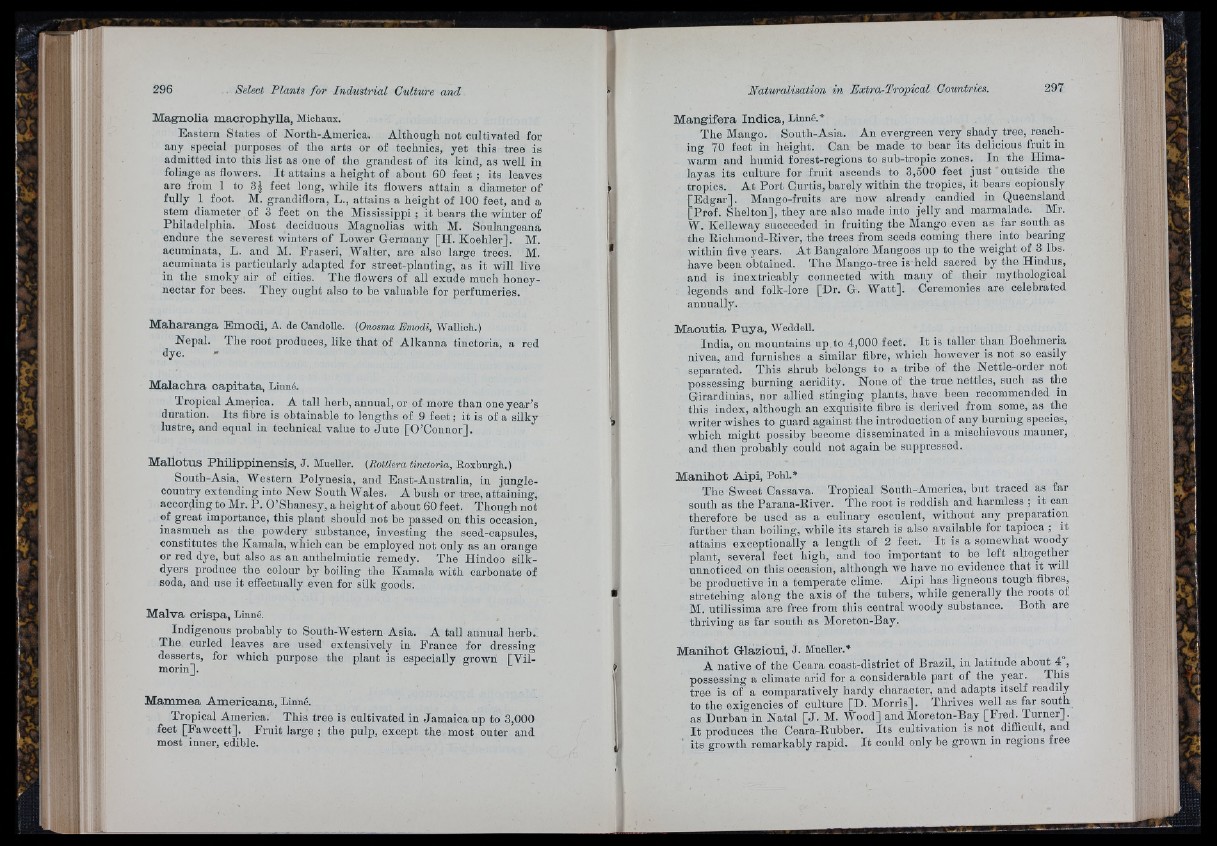
M a g n o lia m a c r o p h y lla , Michaux.
Eastern States of North-America. Although not cultivated for
any special purposes of the arts or of technics, yet this tree is
admitted into this list as one of the grandest of its kind, as well in
foliage as flowers. I t attains a lieiglit of about 60 feet ; its leaves
are from 1 to 3 | feet long, while its flowers attain a diameter of
fully 1 foot. M. grandiflora, L., attains a height of 100 feet, and a
stem diameter of 3 feet on the Mississippi ; it bears the winter of
Philadelphia. Most deciduous Magnolias with M. Soulangeaiia
endure the severest winters of Lower Germany [H. Koehler]. M.
acuminata, L. and M. Fraseri, Walter, are also large trees. M.
acuminata is partioularly adapted for street-planting, as it will live
iu the smoky air of cities. The flowers of all exude much honey-
nectar for bees. They ought also to be valuable for perfumeries.
M a h a r a n g a E m o d i, A. de Candolle. (Onosma Emodi, Wallich.)
Nepal. The root produces, like th a t of Alkanna tinotoria, a red
dye. '
M a l a c h r a c a p i t a t a , Linné.
Tropical America. A tall herb, annual, or of more than one year’s
duration. Its fibre is obtainable to lengths of 9 feet; it is of a silky
lustre, and equal in technical value to J u te [O ’Connor].
M a llo tu s P h ilip p in e n s is , J. Mueller. [Rottlera tinctoria, Roxburgh.)
South-Asia, Western Polynesia, and East-Australia, iu jungle-
country extending into New South Wales. A bush or tree, attaining,
according to Mr. P. O’Shanesy, a height of about 60 feet. Though not
of great importance, this plant sbould not be passed on this occasion,
inasmuch as the powdery substance, investing the seed-capsules,
constitutes the Kamala, which can be employed not only as an orange
or red dye, but also as an anthelmintic remedy. The Hindoo silk-
dyers produce tlie colour by boiling the Kamala with carbonate of
soda, and use it effectually even for silk goods.
M a lv a c r is p a , Linné.
Indigenous probably to South-Western Asia. A tall annual herb.
The curled leaves are used extensively iu France for dressing
desserts, for which purpose the plant is especially grown [V ilmorin].
M am m e a A m e r ic a n a , Linné.
Tropical America. This tree is cultivated in Jamaica up to 3,000
feet [Fawcett]. Fruit large ; the pulp, except the most outer and
most inner, edible.
M a n g if e r a I n d i c a , Linné.»
The Mango. South-Asia. An evergreen very shady tree, reaching
70 feet in height. Can be made to bear its delicious fruit in
warm and humid forest-regions to snb-tropio zones. In the Ilima- a layas its culture for frnit ascends to 3,500 feet ju s t outside the
tropics. A t Port Curtis, barely within the tropics, it bears copiously
"Edgar]. Maiigo-fruits are now already candied in Queensland
'Prof. Shelton], they are also made into jelly and marmalade. Mr.
W. Kelleway succeeded in fruiting tbe Mango even as far south as
the Richmond-River, the trees from seeds coming there into bearing
within five years. A t Bangalore Mangoes up to the weight of 3 lbs.
liave been obtained. The Mango-tree is hold sacred by the Hindus,
and is inextricably connected with many of their mythological
legends and folk-lore [Dr. G. Wa tt]. Ceremonies are celebrated
annually.
M a c u t i a P u y a , Weddell.
India, on mountains up to 4,000 feet. I t is taller than Boehmeria
nivea, and furnishes a similar fibre, whicli however is not so easily
separated. This shrub belongs to a tribe of tbe Nettle-order not
possessing burning acridity. None of the true nettles, such as the
Girardinias, nor allied stinging plants, have_ been reoommended in
this index, although an exquisite fibre is derived from some, as the
writer wishes to guard against the introduction of any burning species,
which might possiby become disseminated in a mischievous manner,
and then probably could not again be suppressed.
M a n ih o t A ip i, Pohl.*
The Sweet Cassava. Tropical Sonth-America, but traced as far
soutli as the Parana-River. Tlie root is reddish and harmless ; it can
therefore be used as a culinary esculent, without any preparation
further than boiling, while its starch is also available for tapioca ; it
attains exceptionally a length of 2 feet. I t is a somewhat woody
plant, several feet high, and too important to be left altogether
unnoticed on this occasion, although we have no evidence th a t it will
be productive in a temperate clime. Aipi has ligneous tough fibres,
stretching along the axis of the tubers, while generally the roots of
M. utilissima are free from this central woody substance. Both are
thriving as far south as Moreton-Bay.
M a n ih o t G la z io u i, J. Mueller.*
A native of the Ceara coast-dlstrict of Brazil, in latitude about 4°,
possessing a climate arid for a considerable part of the year. This
tree is of a comparath^ely hardy character, and adapts itself readily
to the exigencies of culture [D. Morris]. Thrives well as far south
as Durban in Natal [ J . M. Wood] and Moreton-Bay [Fred. Turner].
I t produces the Ceara-Rnbber. Its cultivation is not difficult, and
' its growth remarkably rapid. I t could only be grown in regions free